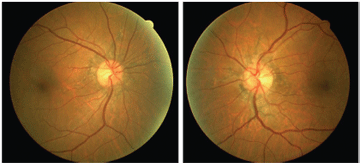 History
History
A 60-year-old black male presented with a chief complaint of blurred vision at near. His systemic history was noncontributory. He denied any present illness. Additionally, the patient said he had no allergies and was taking no medications.
Diagnostic Data
Best-corrected visual acuity was 20/25 O.U. at distance and near. External examination was normal, and there was no evidence of afferent pupillary defect. Anterior segment structures were normal. Intraocular pressure measured 15mm Hg O.U.
The pertinent fundus findings for the patient are illustrated in the photographs.

Fundus photographs (O.D. left, O.S. right) of a 60-year-old male who presented with blurred vision at near. Do you notice anything peculiar?
Your Diagnosis
How would you approach this case? Does this patient require additional tests? What is your diagnosis? How would you manage this patient? What is the likely prognosis?
Discussion
The diagnosis in this case is angioid streaks. These are linear, cracked-line dehiscences of Bruchs membrane, with secondary changes of hypertrophy and hyperplasia in the retinal pigment epithelium. Angioid streaks may be progressive or degenerative, with varied presentation of color, distribution and retinal involvement.1-7 The most commonly recognized characteristic is the mottled appearance of the fundus, which is described as peau d" orangethat is, it appears to have the color and texture of an orange peel.
One of the most serious sequelae is extrafoveal or juxtafoveal choroidal neovascularization, with subsequent serous and hemorrhagic detachment of the fovea.6,7 The neovascularization, in turn, could cause disciform scar formation secondary to its innate nature to rupture, leak and bleed. The most prevalent systemic associations are pseudoxanthoma elasticum, Pagets disease of the bone, sickle cell hemoglobinopathies, Marfans syndrome and Ehlers-Danlos syndrome.3
For this patient, all testing related to possible and probable systemic conditions was negative. We increased the patients add power to address his chief complaint, and will continue to monitor him periodically for any sign of systemic disease or choroidal neovascularization. We provided pertinent education regarding the potential list of associated systemic complications. Additionally, we informed him that the condition was most likely secondary to age-related changes.
1. Peabody RR, Warren H. Angioid streaks in macular disease. In: LEsperance FA Jr, ed. Current diagnosis and management of chorioretinal disease.
2. Deutman AF. Macular dystrophies. In: Ryan SJ, ed. Retina, 2nd ed. Vol. 2.
3. Federman JL, Shields JA, Tomer TL, Annesley WH. Angioid streaks. In: Yannuzzi LA, Gitter KA, Schatz H, eds. The Macula a Comprehensive Text and Atlas.
4. Gass JDM. Angioid streaks. In: Gass JDM, ed. Stereoscopic Atlas of Macular Disease Diagnosis and Treatment. Vol. 1.
5. Clarkson JG, Altman RD. Angioid streaks. Surv Ophthalmol 1982;26(5):235-46.
6. Miller DG, Singerman LJ. Vision loss in younger patients: a review of choroidal neovascularization. Optom Vis Sci May;83(5):316-25.
7. Mennel S, Barbazetto I, Meyer CH, et al. Ocular photodynamic therapy--standard applications and new indications (part 1). Review of the literature and personal experience. Ophthalmologica 2007;221(4):216-26.

